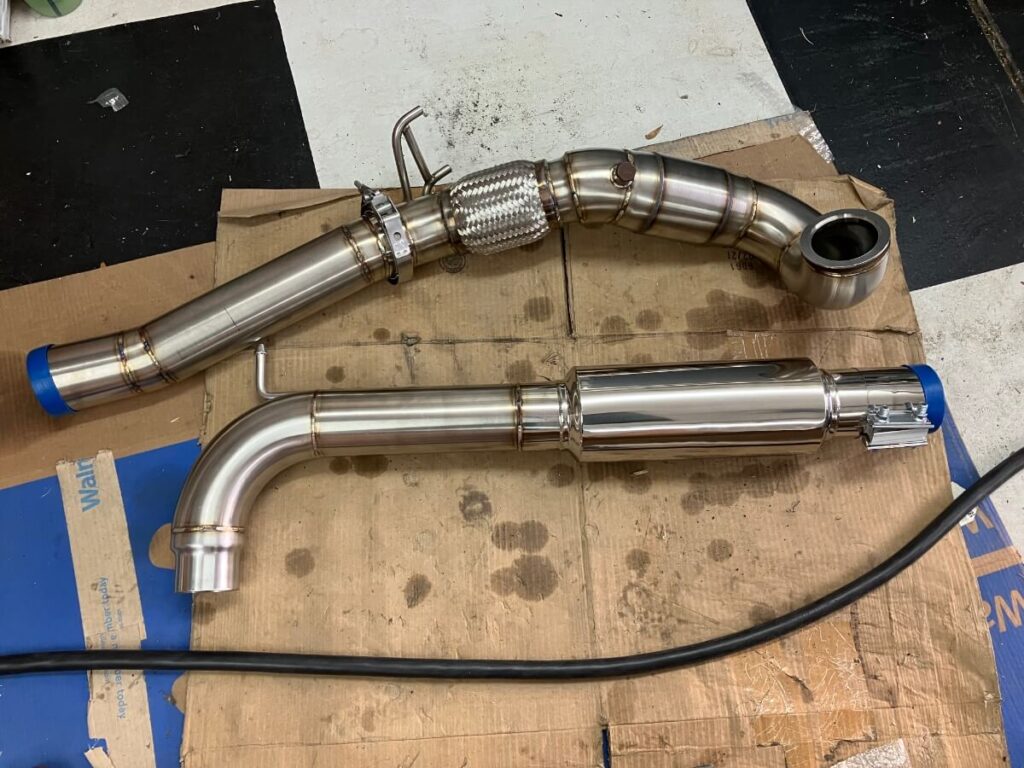Table of Contents

1. Background
1.1 Summary
This page discusses a plan to compare several popular aftermarket Engine Computer (ECU) tunes available for the Mk7 GTI that are installed using the Cobb Accessport.
Key engine operating variables are logged along with the vehicle acceleration rates. From this data, estimates are made of engine power output.
Power and torque measures are also recorded using a DynoJet dynamometer.
1.2 Previous tests
This is my first test using an IS20 turbocharger on my 2015 Mk7 GTI, the car was purchased used and already had an IS38 turbocharger.
I am unaware of a similar comparison of this scope that has been performed.
2. Purpose of test
Record data to support the decision-making process in purchasing an aftermarket Off-The-Shelf ECU tune for a Mk7 GTI.
Utilize the operating variables to gain insight into the different tuning approaches of ECU tuners that are within the scope of this test.
Without measurement we rely on luck, which means we’re either being naïve or ignorant about what truly affects our success.
Author Unknown
3. Products under test
3.1 Cobb Mk7 ECU tunes
Cobb Accessport-based ECU tunes for a “Stage 2” Mk7 GTI using 93-octane fuel were selected for this comparison.
Several factors led to this decision. I already had the Cobb Accessport and based on observations of discussion amongst other Mk7 owners the Accessport seems to be a popular product for installing ECU tunes.
The Cobb Accessport can install software from different vendors, simplifying installing different versions of ECU software.
Stage 2 software was selected because my GTI is equipped with the Baun Performance 4″ GESI catted aftermarket Mk7 downpipe, and an aftermarket downpipe is what “Stage 2” software is intended for use with. Also, the results of an IS20 Tune poll showed a majority of users with a “tuned” IS20 elect to use a Stage 2 version of the software.

Software that is being compared is:
- Cobb Stage 0 (stock GTI) tune (Included with AP)
- Cobb 93 octane Stage 2 tune (Included with AP)
- EQT – OTS 93 octane Stage 2 ($175)
- SneekyTuned – OTS 91-93 octane Stage 2 ($150)
- Stratified – OTS 93 octane ($100)
Criteria for selecting these tune suppliers were that they are United States-based and offer “off-the-shelf” (OTS) tunes for the Mk7.
Note: The Cobb Stage 2 tune is intended for use with a stock downpipe. It is unknown what performance differences this tune has with the no longer available Cobb Stage 3 tune that was intended for use with aftermarket downpipes.
Note: Vendor 5150 was contacted to learn if the business was still selling Cobb Accessport tunes for the Mk7 but no response was received.
3.2 Measurement instruments
Vehicle acceleration data will be measured using a RaceBox performance meter and Dragy datalogger.
Engine variable data will be logged using the Cobb Accessport and custom logging tools.
Other variables from non-organic sensors will be measured using a DATAQ DI-2108 datalogger and DI-149 datalogger.
Wheel horsepower and torque will be recorded using a DynoJet chassis dynamometer.
3.3 Mk7 GTI
The GTI being used in this comparison is a 2015 model year SE trim line, no performance package, with the following aftermarket engine-related equipment installed:
- Eventuri intake
- Stock accordion hose
- Shuenk turbo inlet elbow
- GFB T9381 DV+
- IHI IS20 turbocharger
- 034 Motorsport turbo muffler delete
- aFe Power charge pipes
- AMS intercooler (bicooler configuration)
- Neuspeed front mount intercooler
- HPA high-pressure fuel pump
- APR catch can
- 034 Motorsport coils packs
- 034 Motorsport Density Line mounts
- Fluidampr harmonic damper
- Baun Performance 4″ GESI catted downpipe
- Baun Performance 3.5″ resonated mid-pipe
- AWE Tuning track exhaust with Magnaflow muffler
4. Scope of test
4.1 Test environment
Testing will take place in the Orlando Florida area.
Temperature conditions as reported by the GTI ambient air temperature sensor will be recorded during each data collection session.
The road slope is recorded by the RaceBox and Dragy dataloggers.
A FWD Dynojet dynamometer located at Lamotta Performance in Orlando will be used for dyno measurements.
4.2 Test and test conditions
After each tune’s results have been recorded another tune will be flashed to the ECU until all tunes have been tested.
Data will be collected by accelerating the GTI on the street at full throttle starting at 1900-2100 RPM and concluding at 6300-6500 RPM.
The transmission will be placed into the third (3rd) gear for data collection on the street.
Acceleration data recording will occur with the DSG Transmission in Drive mode in third gear.
On the dynamometer, the transmission will be operating in fourth gear.
93 octane gasoline with 10% Ethanol content will be used.
4.3 Test criteria
4.3.1 Assessment standards
The purpose of the test is the collection of data for making relative comparisons. There are no threshold or objective requirements.
Success / Failure criteria – The Dragy datalogger has defined criteria for a valid or invalid run based on the road slope. Only measurements made during a valid run will be used for power calculations and acceleration time comparison.
Engine variables such as AFR, Boost, and Timing will be averaged for each software version to present overall trends. See the Power Analysis page for information about how the sample sizes were determined.
4.3.2 Completion standards
Testing with each software version will end when sufficient samples have been recorded to meet the desired Statistical Power and Level of Significance for the summary statistics.
Sample variance and effect size used in the power analysis are based on calculated values for the peak wheel horsepower.
4.4 Limitations to scope
The selection of tuners for comparison is limited to three well-known aftermarket tune suppliers and the products offered with the Cobb Accessport. A search of the Cobb Dealer network may return other suppliers of OTS tunes for the Mk7 GTI.
5.0 Method of test:
5.1 Test methods and procedures
Street data is recorded primarily via a full-throttle third-gear acceleration from ~2000-6300 RPM that is repeated several times to produce statistical confidence in the average values.
Throttle response data is recorded by measuring longitudinal acceleration during routine street driving.
DynoJet dynamometer information is recorded during a fourth gear pull on the dyno which is repeated twice for a total of three pulls.
5.2 Support requirements
Lamotta Performance – Dynamometer.
6.0 Project management:
6.1 Supplies
| Brand | Method | Support Status | Tune |
|---|---|---|---|
| Cobb | Home Flash | Have Device & Software Access | Stage 0 / Stage 2 – 93 |
| Stratified | Home Flash | Have Device & Software Access | 93 octane |
| SneekyTuned | Home Flash | Have Device & Software Access | Stage 2 – 91/93 octane |
| EQT | Home Flash | Have Device & Software Access | Stage 2 – 93 |
| 5150 | Home Flash | Have Device / No response to inquiry | Stage 2 – 91 |
6.2 Reports
This video provides an overview of the results, details of which are found on the linked pages below the video.
Results from the data collection and analysis are presented on pages linked from this section:
- See the Street Data Collection for detailed data from each Cobb tune that was used in this test. This data was recorded during the 3rd gear street pulls.
- See the Street Summary page for comparison results of the Cobb tune data logged on the street.
- See the Dyno Data Collection page for detailed results from each tune on the dyno. This data was recorded during the 4th gear pulls on the dyno.
- See the Dyno Summary page for comparison results for the tested Cobb tunes recorded on the dyno.
7.0 References:
- Virtual Dyno utilization for estimating wheel horsepower
- Power analysis for determining street pull sample size
- Discussion about the Noise-related variables and their relationship to preventing damage from knock (detonation)
